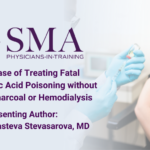Abstract | May 7, 2021
A Rare Case of Treating Fatal Acetylsalicylic Acid Poisoning without Activated Charcoal or Hemodialysis
Introduction:
Salicylate poisoning carries a significant mortality risk. Fatal aspirin intoxication can occur after ingestion of 10 to 30g by adults. Clinical features include tinnitus, vertigo, vomiting, diarrhea, altered mental status, hyperpyrexia, coma, noncardiac pulmonary edema, and death. Most common acid-base disturbances include primary respiratory alkalosis or a mixed primary respiratory alkalosis-primary metabolic acidosis.
Case presentation:
A 20-year-old male ingested a lethal dose of approximately 31.200mg of acetylsalicylic acid, and was transported to our hospital approximately 6 hours later. Patient reported that 2 hours after the lethal dose of aspirin ingestion he started experiencing tinnitus, hearing loss, nausea, weakness and later started vomiting uncontrollably. Upon arrival patient was drowsy, confused but arousable. Initial vitals: BP 96/60, HR 96, EKG with NSR, T 98.5 F, RR 18, 89%O2 saturation on RA. Initial ABG on RA showed pH 7.4, pCO2 32.8, PaO2 53, HCO3 22, AG 9, urine pH 6, Calcium 8.0, Potassium 4.5, Platelets 213, Creatinine 0.9, HCO3 23. Initial salicylate level 52.7. Past medical history include major depressive disorder, bipolar disorder, polysubstance abuse.
Management:
As per guidelines, after contacting poison control, we started the patient on IV D5Water with added bicarbonate in attempts to alkalinize the serum and urine with goal serum pH above 7.5 and urine pH goal above 7. We were checking urine pH, blood pH, salicylate levels and electrolytes every 2 hours. No activated charcoal administration or hemodialysis had to be performed as patient responded very well to initial treatment.
Outcome:
Initial salicylate levels were in the fatal range of 52.7, but gradually decreased to 12.1 in less than hrs. Patient’s mentation returned to baseline within several hours after initial intravenous bicarbonate treatment. Although activated charcoal and hemodialysis are strongly recommended for patients with lethal doses of acetylsalicylic acid, by carefully evaluating vital signs, urinary and serum pH, we were able to successfully treat our patient with alkaline diuresis and supportive care.
Learning Objectives:
- Serum salicylate concentrations above 40 mg/dL (2.9 mmol/L) can be lethal. In patients with clinical signs of. salicylate poisoning, serum concentrations should be measured every two hours until two consecutive levels show decreasing values.
- Salicylates stimulate the respiratory center causing hyperventilation, wash out of CO2 leading to respiratory alkalosis, followed by anion-gap metabolic acidosis, due primarily to the accumulation of organic acids, including lactic acid and ketoacids.
- The main treatment of salicylate poisoning is via systemic pH “alkalinization” accomplished by administering IV sodium bicarbonate. Alkaline pH decreases diffusion of salicylate anions into the central nervous system and also traps salicylate anions within the renal tubule and preventing them from re-entering systemic circulation. Activated charcoal can prevent ongoing absorption of retained aspirin concretions or enteric coated tablets. Nephrology consult and hemodialysis should be considered for all patients with clinical evidence of severe intoxication, not improving on intravenous bicarb infusion.

